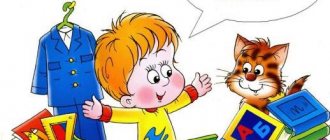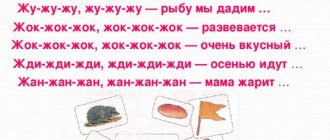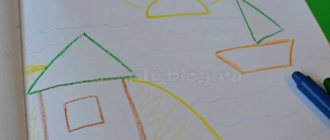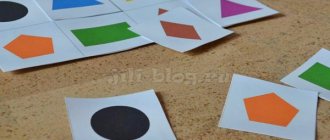Almost all parents understand that the time will definitely come when they will need to learn the letters of the Russian alphabet with their child. And they face a lot of questions. For example, at what age will learning be most successful? Or how to make classes interesting for children? And, in general, how to study it?
Children learn better through play
You can start learning the alphabet at any age. Some parents begin learning the alphabet when the little person is not even one year old. And many people don’t think about it until school. Of course, these are extremes. In the first case it is still early, in the second it is already late. The optimal age for learning letters is 4.5–5 years. During this period, children develop the ability to analyze, their interest in their surroundings greatly expands, and their ability to absorb information increases. It is at this time that the child may have a desire to learn to read.
Letters of the Russian alphabet
Learning letters: where to start
In what order should I learn the letters? Do you need to learn the alphabet? Should I start with vowels or consonants?
Let's be clear, so:
1. There is no need to learn letters in alphabetical order.
2. Don’t learn letters mixed up: vowels and consonants.
3. Be the first to learn 10 letters representing vowel sounds with your child.
We wrote in detail about how to learn 10 vowels in 5 lessons. The technique is really very effective and simple. Any mother can do it.
4. It is better to learn consonants after vowels.
5. Name the sounds, not how the letter is pronounced in the alphabet.
When to start?
There is no universal answer to the question.
To find it, you need to start from several initial data. And both from the child himself and from the parents. First of all, all children are different. Everyone has different abilities, different interests and different needs. Except, of course, the basic ones. One child may not be interested in books as such until school. And then receive scoldings from parents and teachers for poor performance despite all their efforts.
And the other, without any techniques, possessing insatiable curiosity and abilities, will quietly learn to read in a corner. And it will be revealed completely by accident. And it doesn’t matter whether the child was three years old or seven.
Secondly, parents are also different. Some simply and naturally involve their children in the world of their own interests. Not because they are concerned about early development issues. But because it seems natural to them to include the baby in their life.
Others are guided by their own considerations. Such parents absolutely need their children to learn several languages, do math, and go to all the clubs in the area.
That is, it turns out that the concepts of “early” and “late” turn out to be very flexible. Don't look for a universal norm, look at your own child. You will definitely understand when it is too early for you and when it is time.
That is, even if someone’s child can quickly read syllables, this does not mean that it’s time for yours too. And vice versa. A child may still be a toddler in your eyes.
But a keen interest in books, turning pages and looking at pictures is a signal that you can try to move on to letters. You may not succeed the first time, but you can try.
If you still need universal advice, then it is this: let the baby grow up a little and get out of infancy.
Let him learn to speak. As soon as the baby learns more or less normal communication with you, you can begin to consciously teach him something.
Focus on the age of 3-4 years, and then look at the circumstances.
Now let's move on to the process.
How to teach a child the alphabet at 3-4 years old
If you decide to teach your child letters at 3 years old, remember that nothing can be done through force, only games, only entertaining exercises and NO FORCE. These recommendations are relevant for any age, because you do not want to develop an unwillingness to learn and go to school in the future.
- Don't expect your child to remember many letters right away. Don't set out to learn the entire alphabet; it will take time.
- Give your child new material twice a week, and on the remaining days, repeat and consolidate what you have learned.
- With a child 3-4 years old, it is enough to exercise 2-7 minutes a day.
- Learn vowels in pairs, so it will be easier for your child to remember: A - Z, O - Yo, U-Yu, Y - I, E - E.
- Before introducing your child to consonants and starting to learn to read, make sure that knowledge of all vowels has been brought to automaticity.
Preschool age is the best period for learning letters
Many parents with small children have a question: when is the best time to start learning the alphabet? There are several opinions on learning letters by preschoolers:
- According to many modern parents, it is necessary to teach a child to read as soon as he speaks. They begin to master original techniques and purchase special manuals. However, there is not always enough patience and knowledge to complete the training that has begun. Therefore, the task of parents is to organize home schooling in such a way that both adults and children can do it.
- According to psychologists, there is no need to rush to teach your child the alphabet. If a child is not ready to perceive educational material, he may develop a persistent reluctance to learn letters and subsequently read. After all, this is a rather difficult task, requiring mental tension, attention, and speech. Experts believe that the optimal age for learning letters is 4–5 years, when the child is psychologically ready to learn. At this age, interest in everything new and a desire to be like an adult are more evident. Adults should take advantage of this interest and desire to learn new things.
- According to teachers (authors of early learning to read N. Zaitsev, G. Doman, V. Voskobovich), you can teach your child the alphabet much earlier than preschool age, for example, at one to two years old, if the baby shows such a desire.
The main thing that parents need to remember is that teaching should be free of coercion. Important: parents need to understand why we teach letters with a small child. If a preschooler under 4-5 years old really wants to learn the alphabet, then his desire should be encouraged. And if this is a tribute to fashion and the parents’ desire to keep up with others, then there is no need to rush. It is better to focus on general intellectual preparation and development of the speech apparatus by reading books, composing creative stories, inventing fairy tales, memorizing poems and sayings. Then preparation for school in senior preschool age will take place without stress. The preschooler himself will strive to keep up with his peers, acquire new knowledge, and actively behave in home classes to learn the alphabet.
How to learn consonants: a game technique
There are many more consonants than vowels. Studying them will require more patience, effort and time. But everything will work out if you strictly follow the recommendations and take your time.
Prepare a table. Each table consists of six rows. On the top line, write or type hard consonants in blue and soft consonants in green. On the remaining lines, write short open syllables.
| BY | |
| BO | BYO |
| BOO | BYU |
| WOULD | BI |
| BE | BE |
| VYa | |
| IN | WHAT |
| VU | VYU |
| YOU | IN AND |
| VE | BE |
| GY | |
| GO | GYO |
| GU | GY |
| Gee | GI |
| GE | GE |
| DY | |
| BEFORE | DE |
| DU | DU |
| YES | DI |
| DE | DE |
| ZY | |
| ZO | ZY |
| memory | ZY |
| PS | ZI |
| ZE | WE |
| LA | |
| LO | LE |
| LU | Best Junior |
| LY | LI |
| LE | LE |
- Together with your child, sing songs of vowel sounds: in a rough low voice A, O, U, Y, E and in a high thin voice I, E, Yu, I, E.
- Say the consonants in the top line of the chart clearly. Work with 6 tables in each lesson.
IMPORTANT! Make sure that the child and you yourself pronounce the consonants clearly, so that no extraneous vowels Y or I . If the child gets used to saying D y, S y instead of the pure sounds D , S , then he will read incorrectly. The most difficult things to pronounce are the pure sounds B, V, G, D; B, B, G, D. The rest are easier, especially the deaf. Z and ZH correctly for example, is very simple. Ask your child: “How does a big mosquito buzz? Z-Z-Z. No, not Z s, but Z-Z-Z! The mosquito does not know how to say Zy , it does Z-Z-Z . How does a small mosquito buzz? ZZ-ZZ-ZZ . Komarik does not know how to say Z and, he does Z-Z-Z-Z . This is what we call these letters: Z-Z-Z and ZZ-ZZ-Z .”
- Sing the syllables in the same way as you did with the vowels.
- b in the tables and tell them that it is called a “soft sign.” Remind him of its name from time to time.
The letter b does not indicate a sound, but only INDICATES the softness of the consonant.
- Write Y . Name what this sound sounds like. Give examples of words that begin with this sound: iodine, yogurt, yogi.
the very name of the letter “ And short” later when he learns the alphabet. From time to time, remind your child about this letter by PRONING IT WITH A SOUND.
- Return to these tables several times a day and sing the warehouses with your child. Do this regularly.
- When you see that the child is doing everything correctly, replace the 2 tables with two new ones.
| MY | |
| MO | MIO |
| MU | Manchester United |
| WE | MI |
| ME | ME |
| AE | |
| BUT | NOT |
| WELL | Nude |
| WE | NI |
| NE | NOT |
The technique is the same. Sing all 6 tables daily with your child. As a result, the child will repeat the old ones and learn 2 new letters.
- Again replace the 2 tables with two new ones, etc.
If you stick to the plan “new things 2 times a week, repeat the rest of the days,” your child will learn 32 letters of the Russian alphabet in a month. Ъ to your child later, when he begins to read and encounters this letter in words.
IMPORTANT! In the Russian language there are twin sounds and warehouses: ZH-ZH, ZH-ZHYO, SH-SH, SHO-SHYO, CH-CH, CHO-CHE, SHCH-SHCH, SHCHO-SHCHYO, TSY-QI . They are spelled differently, but sound the same! Be sure to draw your child's attention to this.
A bit of "general theory"
First of all, it is important to understand that a little person’s speech develops in stages. Experienced parents probably remember that in the first months of life their baby chanted vowel sounds, then began to hum, pronouncing syllables with simple consonants, then came the first onomatopoeia (“am-am”, “av-av”) and the first words.
- Closer to one year, the child can say “mom,” “dad,” “baba,” “uncle,” “give,” and perhaps several other words. He also uses the “wrong” words (“kup-kup”, “bye-bye”).
- From one to two years old, the baby learns to formulate the first simple sentences (“I’ll have soup”, “Dad, give me”). If the syntactic structure of a sentence (subject - predicate) can be traced, no attention is yet paid to the purity of sounds: the child’s articulatory apparatus is not yet sufficiently formed for this. But the so-called “passive” vocabulary, which began in the first months, is being replenished by leaps and bounds: the child learns to understand new words, remembers their pronunciation and meaning, although he does not yet know how to pronounce them. Later they will turn into his active speech. Now he no longer just pronounces the “vocabulary set”, but listens to how he says these words and the sounds in them, and is able to evaluate whether it is correct or not.
- Around 3 years old, a child learns to repeat short poems, as well as construct complex sentences with the words “because”, “which”, “so that”. Most often, it is at this age that whistling sounds (S, Z, C) “ripe.” But even if they are still being replaced (for example, by the sound T), but the child’s intelligence is developing normally (he understands speech addressed to him, knows the names of his relatives, or that animals also have mothers and fathers) - there is no reason to worry.
- By the age of 4, the child should know general words (what are dishes, transport, toys, clothes). The pronunciation may not yet be very clear (hissing and P are the ones that suffer most often).
- At the age of 5, a child must correctly pronounce all sounds, since by this time the parts of the brain responsible for the development of speech have been sufficiently formed, and the speech apparatus has reached the required “condition” (provided that the child has been constantly trained: speech itself is not will come “out of nowhere”).
Magnetic alphabet
Another one of the most common ways to teach a child letters. Surely many young parents had such magnetic boards when they were children.
You can work with the magnetic alphabet, just like with cards: each time, attaching a letter to the board, show it to the child and clearly pronounce it, vowels in a sing-song manner, consonants - clearly pronouncing their sound. After the child has memorized the vowels and consonants, you can move on to learning the alphabetic sequence and syllables.
Learning through games
Reading skill requires constant training. To make it easier to remember what you read, you need to look at pictures in books and discuss situations. To show your child what books are and how interesting it is, you need to play:
- Game for mastering letters . Together with your child, come up with images for the letters that he will play with. All images should be memorable and bright. It is possible to make cards with letters with images of animals yourself.
- Games for adding syllables . At the base, make circles with written syllables and pictures that show the baby which word needs to be added. For example, you can make a picture of a river. The kid chooses two circles. One says RE, and the other says KA. Or a picture of porridge. There are also two pictures, where on one is KA, and on the other is SHA.
- Games to develop reading skills . There is a game “Word”, which involves making up words from syllables and letters mixed up. you can come up with situations, for example, Ira wanted to give her granny gifts and wrote them down. But a hurricane suddenly hit and mixed everything up. We need to help Irochka remember what she needed to give to grandma by composing and mixing up the syllables of the word.
Children's coloring pages
There are plenty of such materials for teaching a child letters, and they are varied. There are coloring books where you need to color in the letters, and there are those where you need to connect the dots to make a letter. As a rule, each exercise is accompanied by a funny rhyme in order to quickly and better remember the material covered. In a word, the choice is up to the parents.
Of course, cards and magnetic alphabets are time-tested methods and auxiliary materials, but if you want to add variety to your child’s usual activities, then alternative and fun ways to teach your child letters will come to the rescue.
Cubes
If you don’t have time to make cards yourself, then bright cubes with pictures for each letter will come to the rescue. This is a quick and familiar way to teach a child to memorize the letters of the alphabet. Nowadays you can find a wide variety of cubes: colorful, funny, soft, wooden or plastic.
With cubes, you can also come up with a variety of games for memorizing letters at home, which will help awaken an interest in learning the alphabet and reading in a three- to four-year-old child.
Associations
This game can add variety to activities with cubes or cards. For example, the letter “F” looks like a “bug” - you can add antennae and eyes to it on a card, or invite the child to do it himself.
The letter “D” can become a “house”, acquire a painted window and a pipe. This fun method can help not only quickly learn the alphabet, but also develop the creativity of a preschooler.
However, there are a number of pitfalls here. Teachers working with preschoolers note that in this case there is a risk of learning not the sound, but the proposed association itself, in which the letter “D” turns into the letter “house”. Therefore, this method will be good in combination, as a pleasant relief after “standard” learning the alphabet.
How to understand that it’s time: signs of psychological readiness
- The child speaks fluently in sentences and understands the meaning of what is said.
- The child distinguishes sounds (what speech therapists call developed phonemic hearing). Simply put, the baby will easily understand by ear where the house and the bow are, and where the tom and the hatch are.
- Your child pronounces all sounds and has no speech therapy problems.
- The child understands directions: left-right, up-down. Let's skip the point that adults often confuse right and left. To learn to read, it is important that the baby can follow the text from left to right and from top to bottom.
How to learn the alphabet online - 5 proven simulators
When a baby learns the alphabet with a tablet in his hands, the information is remembered more easily, because the child is completely focused on the bright picture. We have selected for you several interesting applications that can be downloaded to your tablet and offered to your child as an alternative to books and posters.
Talking ABC - Alphabet
The application has free and paid content, the tasks are all clear and accessible. In addition, the exercises differ in difficulty level. The kid will be able not only to learn the letter, but also to color it. The application is free, but you can also purchase the full version.
ABC for children
The child learns all the letters of the alphabet from bright pictures. The application interface is simple, accessible, and has sound. Learning occurs not only through pictures, but also through riddles. The application is free.
«Alphabet. Let's learn letters. «
This application is suitable even for the little ones. Especially if your child loves dinosaurs. You can study together with your child - you on the phone, for example, he on the tablet.
ABC coloring book
A real find for children who love to draw. In this application, the baby learns letters, gets acquainted with their writing and shows his creative abilities. An excellent educational game for those who are getting acquainted with the alphabet and are already learning to read. The application is free.
Letters: learning to read is fun
First, the child learns the interactive alphabet, and then can play with the letters. To do this, he needs not only to name the letter, but also to pronounce the sound, and then name the object whose name begins with this letter. The short version of the application is free, the full version is paid.
Electronic poster “Talking ABC”
The educational sound poster is a great addition to standard alphabet learning techniques.
It combines visual and audio perception, allowing you to learn the letters and sounds of the alphabet, as well as numbers from 1 to 33. The poster features several modes - song, riddle or task, which allows you to diversify the learning process.
The posters differ in sound and pronunciation principles. It is recommended to choose those where there is a pronunciation of letters as sounds.
Learning the alphabet is an important step in the life of every child, which will allow them to gain new knowledge and analyze it. It is worth treating this period with patience and helping your child learn through a playful approach and support.








